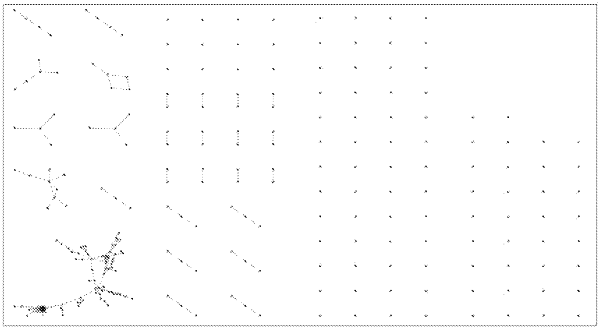| CPC G06F 30/28 (2020.01) | 9 Claims |

|
1. A method for evaluating fracture connectivity and optimizing fracture parameters based on complex network theory for high production of oil and gas wells, comprising the following steps:
Step 10: obtaining a distribution law of natural fractures in a formation and characteristic parameters of natural fractures in the formation based on previous knowledge of natural fractures in the formation and statistical analysis of fractures in a core;
Step 20: establishing a discrete fracture network model of natural fractures based on the distribution law of natural fractures in the formation and the characteristic parameters of natural fractures in the formation, wherein the specific process of establishing the discrete fracture network model of natural fractures is:
Step 201: randomly generating fracture data of the discrete fracture network model of natural fractures based on the distribution law of natural fractures in the formation;
Step 202: determining coordinates of a center point of the generated fracture data based on the fractal discrete fracture network theory, and establishing a corresponding linear equations of the fractures with the coordinates of the center point of the fractures and the fracture data to calculate coordinates of the end points of the generated fracture data, and to obtain a range of values of the coordinates of each fracture;
Step 203: assigning fracture properties to the fracture center points and establishing a discrete fracture network model of natural fractures;
Step 30: setting hydraulic fracture parameters and determining coordinates of intersection points of the fractures in the discrete fracture network model and an intersection relationship of the fractures according to the discrete fracture network model of natural fractures;
Step 40: converting the resulting discrete fracture network model into a complex network dual topology diagram based on the complex network theory and the intersection relationship of the fractures in the fracture network;
Step 50: calculating an average degree, centrality, and average clustering coefficient of a complex network based on the converted complex network dual topology diagram, and calculating a comprehensive evaluation index based on the average degree, centrality, and average clustering coefficient;
Step 60: setting the hydraulic fracture parameters of a plurality of hydraulic fracture schemes and repeating Step 30 to Step 50 to obtain the comprehensive evaluation index of each of the plurality of hydraulic fracture schemes;
Step 70: determining an optimal hydraulic fracture scheme based on the comprehensive evaluation index of the plurality of hydraulic fracture schemes.
|